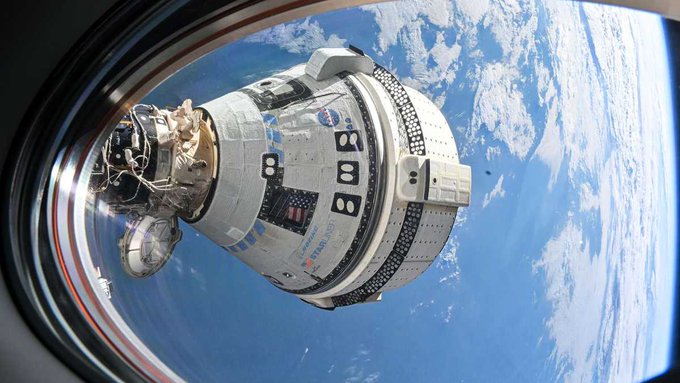NASA astronauts Sunita Williams and Barry “Butch” Wilmore have been stranded on the International Space Station (ISS) for over 50 days due to a malfunction in Boeing’s Starliner capsule, with no immediate return to Earth in sight. Originally scheduled for a brief eight-day mission, the astronauts have been forced to extend their stay indefinitely due to a series of technical issues plaguing their spacecraft.
Former Space System Commander in the US military, Rudy Ridolfi, elaborated on several scenarios that could play out if NASA chooses to go with the Starliner for their rescue. According to the Daily Mail report, a worst-case scenario would see the crew burning up inside the capsule upon reentry.
If NASA does choose to persist with Starliner, Williams, and Wilmore could vapourise upon reentry of Earth’s orbit or be stuck floating in space.
Starliner’s problems lie in the service module, which is like the control centre for the entire ship. It contains systems that control the thrusters, power, as well as water and oxygen for the occupants. The module is located at the bottom of the capsule and is also critical for aligning the craft for reentry before it jettisons away before reentry.
The service module must put the capsule at an angled altitude for it to re-enter Earth. If the angle is off, the craft would bounce off the atmosphere and leave NASA scrambling to locate it in orbit. If the angle is too steep, there’s more friction and a greater chance of burning up in the atmosphere, vaporising the occupants.
In case the angle is too shallow, the spacecraft could bounce off the atmosphere and be catapulted back into space like a stone across a pond. “So long as the capsule is lined up correctly for reentry, everything’s fine,” Ridolfi said, as quoted by Dailymail.
“[If the capsule is not lined up], they either burn up or bounce back into space,” he said. “If the Starliner Service Module places the capsule in too steep of a reentry window, then the capsule ablative heat shield would probably fail,” he added.
Five thrusters encountered failure during the 24-hour journey that took the two astronauts to the ISS back in June. A major concern is that more thrusters could fail on the return leg, which can leave the two astronauts floating in limbo, somewhere between the ISS and Earth, according to the Daily Mail report.
Health concerns: Toll of extended spaceflight
As the days turn into weeks, concerns over the health and well-being of the stranded astronauts are growing. Reports have emerged that Sunita Williams is experiencing significant health issues, including a vision problem known as Spaceflight Associated Neuro-ocular Syndrome (SANS). This condition, caused by prolonged exposure to microgravity, is leading to a gradual loss of eyesight, raising alarms about the long-term impact of the mission on her health.
SANS is not the only risk. Extended stays in space are known to cause other health issues, such as bone density loss, which could have lasting effects on the astronauts’ physical well-being. NASA’s medical teams are closely monitoring both Williams and Wilmore, but the situation underscores the inherent risks of space exploration.
Starliner Setback: Major blow to NASA, Boeing
The Starliner capsule, a critical component of NASA’s Commercial Crew Program, was launched June 5, 2024, with the goal of conducting a test mission that would see Williams and Wilmore spend just eight days on the ISS before returning to Earth. However, the mission quickly encountered problems when last-minute thruster failures nearly prevented the spacecraft from docking with the ISS. Following this, further issues were identified, including helium leaks and malfunctioning propellant valves, making the return trip impossible.
These setbacks have put NASA in a difficult position. Boeing, one of the agency’s key partners, has struggled to resolve the technical issues, leaving the astronauts stranded in space for over 50 days. What was supposed to be a short-duration mission has now turned into an extended stay with no clear solution in sight.
SpaceX: Unexpected lifeline
With Starliner facing persistent technical challenges, attention is now turning to SpaceX’s upcoming Crew Dragon mission, scheduled for launch in September 2024. If the mission proceeds as planned, it could serve as an alternative means of returning Williams and Wilmore to Earth, though this would extend their stay in space to over eight months—far beyond the originally planned eight days.
The Crew Dragon mission is expected to return to Earth in February 2025, offering a potential lifeline for the stranded astronauts. However, this solution is far from ideal, as it would require the astronauts to endure the harsh conditions of space for an extended period, potentially exacerbating the health issues they are already facing.
SpaceX, led by Elon Musk, has already demonstrated its reliability through multiple successful missions to the ISS, including both cargo and crewed missions. The Crew Dragon spacecraft has become a cornerstone of NASA’s crewed spaceflight capabilities, often outperforming expectations. However, for NASA, having to depend on SpaceX to rescue its astronauts after a Boeing failure is a bitter pill to swallow.
Test of endurance
The ongoing Starliner crisis highlights the challenges of human spaceflight and the unpredictable nature of space exploration. Williams, who has already spent 322 days in space over her career, and Wilmore, with 167 days under his belt, are both seasoned astronauts, but even their extensive experience is being tested by the current situation.
PNN & Agencies
